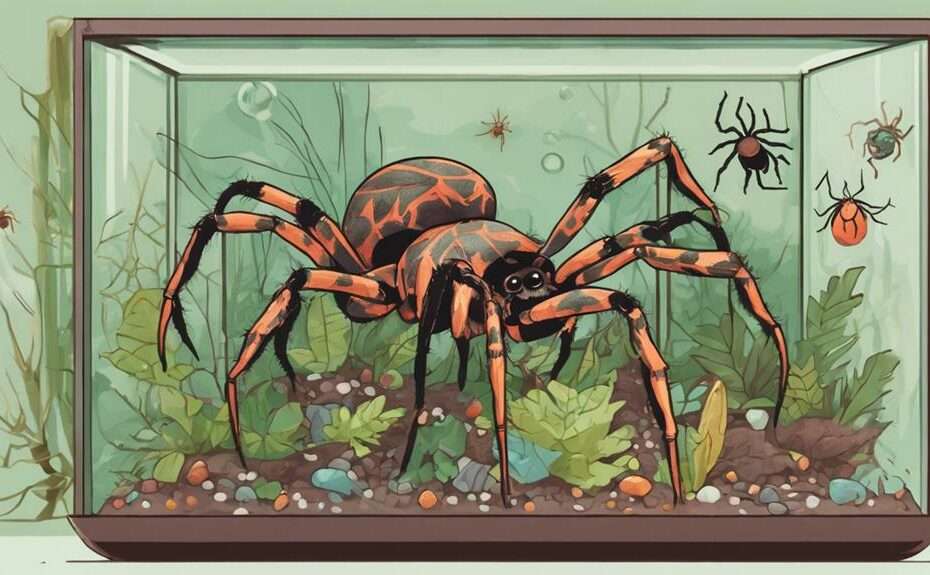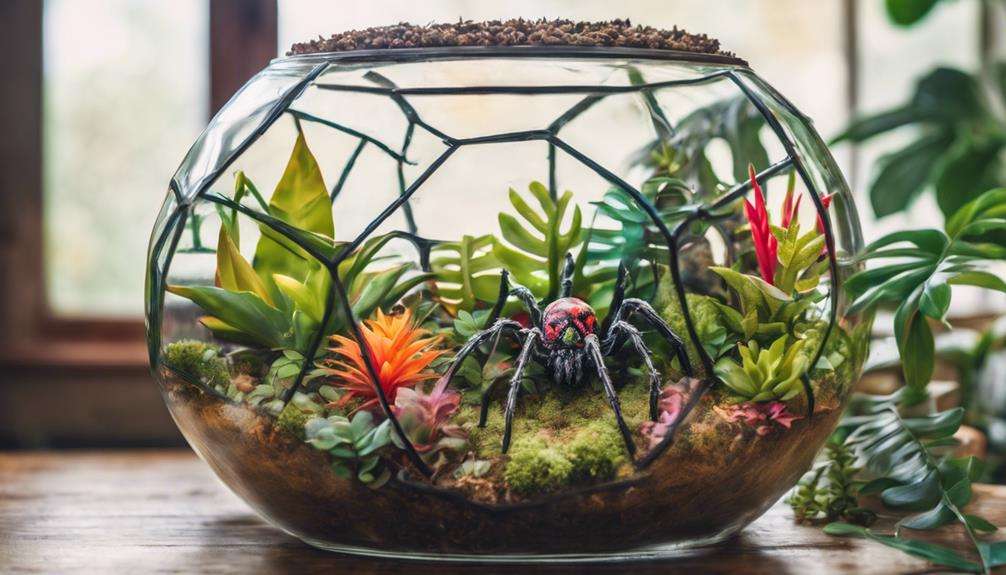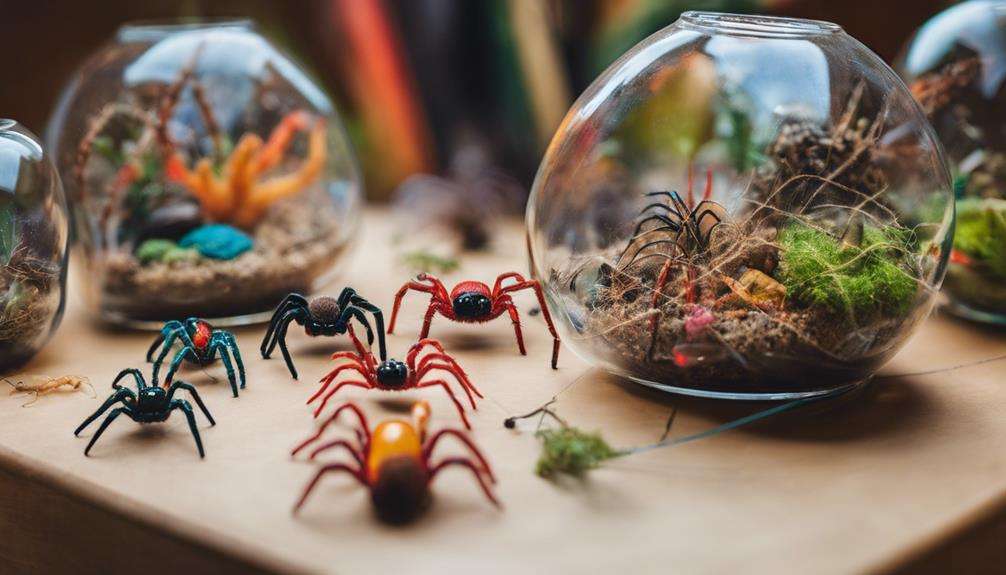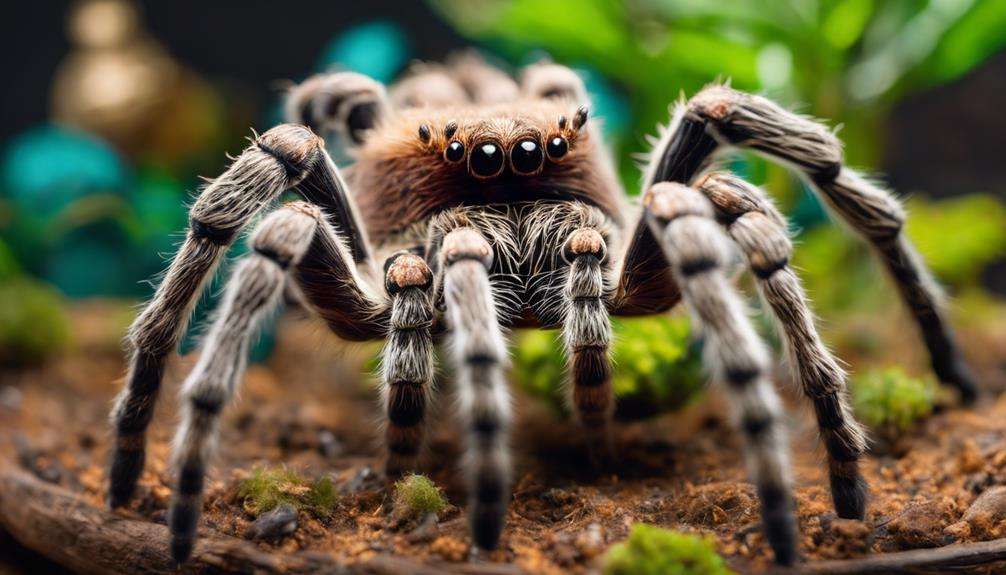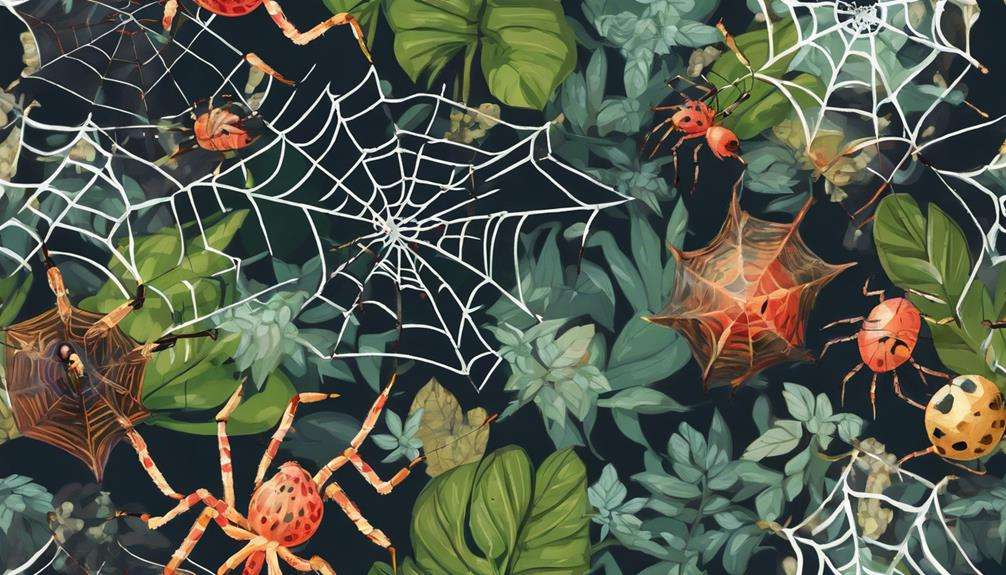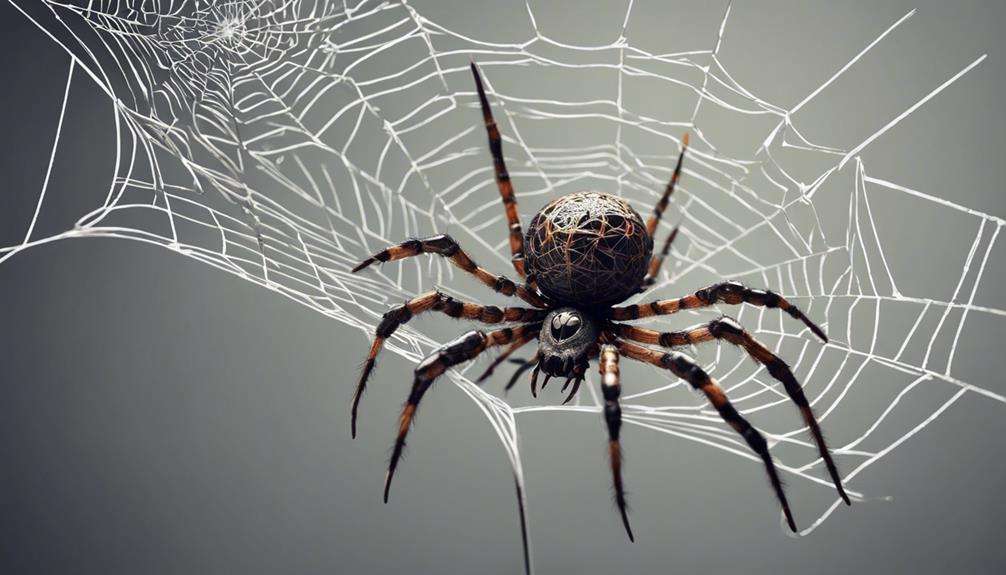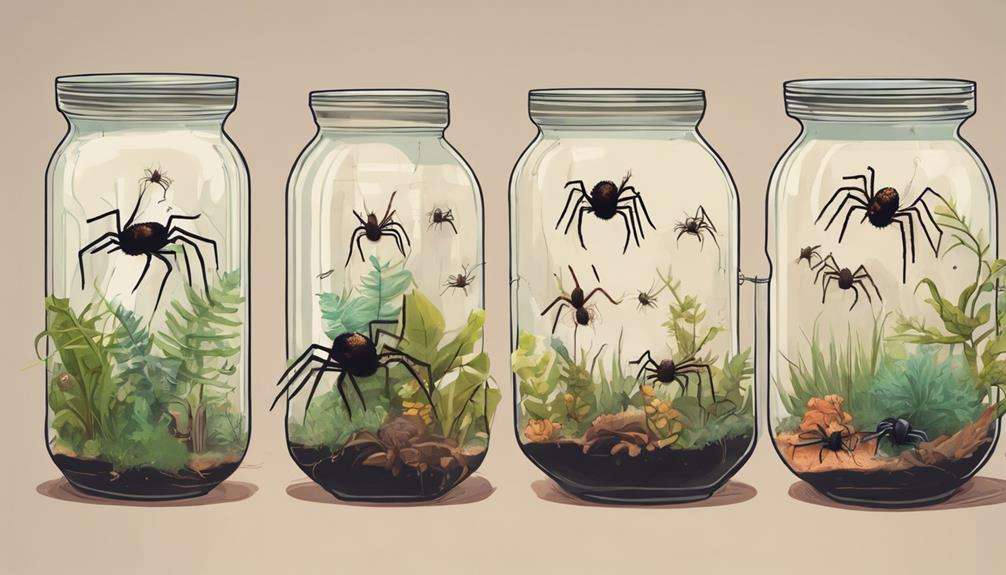Curious about unconventional pets that require expert care and attention?
Imagine the allure of owning a spider companion that demands specialized knowledge and experience.
These fascinating creatures offer a unique insight into the world of arachnids, each with its own mesmerizing traits and intricacies.
Discover the alluring world of spider keeping and explore the complexities that come with nurturing these exotic companions.
Key Takeaways
- Expert keepers appreciate unique spider species like Gooty Sapphire Tarantula for their care challenges.
- Cyclocosmia Ricketti demands specialized care with attention to humidity for optimal health.
- Behavioral insights from spiders like Cyclocosmia offer valuable knowledge for arachnid enthusiasts.
- Spider pets for expert keepers provide a rewarding and challenging experience in studying nature's adaptations.
Tarantula Spider: Poecilotheria Metallica
The Poecilotheria metallica, commonly known as the Gooty Sapphire Ornamental Tarantula, showcases mesmerizing hues of metallic blue on its body, enchanting enthusiasts with its stunning appearance and unique characteristics. This arboreal tarantula species, native to the Gooty region of India, is a master of agility and speed, well-adapted for life in the trees. To replicate its natural habitat, maintaining precise humidity levels is fundamental when caring for this species. Expert keepers are drawn to the challenge of creating vertically oriented enclosures that mimic the tall trees where the Gooty Sapphire Ornamental Tarantula dwells.
Despite its allure, this tarantula possesses potent venom, a trait that demands careful handling and respect from those who keep it. Its beauty and vibrant colors are complemented by its danger, adding to the intrigue surrounding this species. Understanding the balance required to provide the right environment for the Poecilotheria metallica is essential for those who appreciate its unique characteristics and stunning presence in the world of tarantulas.
Trapdoor Spider: Cyclocosmia Ricketti
The behavior of the Trapdoor Spider, Cyclocosmia ricketti, showcases a remarkable blend of stealth and precision in its hunting tactics.
Care for these arachnids requires a keen understanding of their specific environmental needs to support their burrowing lifestyle.
The fascinating features of Cyclocosmia include its distinct shield-like design and robust build, contributing to its effectiveness as both a predator and a well-adapted species in its natural habitat.
Trapdoor Spider Behavior
Crafted with precision and skill, the camouflaged burrows of the Cyclocosmia ricketti trapdoor spider showcase remarkable adaptation in its behavior. This species of trapdoor spiders are unique ambush predators, relying on their intricately designed trapdoors to secure prey.
Cyclocosmia ricketti exhibit secretive behavior, rarely venturing outside their burrows apart from hunting or mating activities. Their trapdoors, made from silk and soil, blend seamlessly with the environment, enabling them to deceive unsuspecting prey.
These spiders patiently wait for potential victims to pass by their burrow entrances before striking with speed and accuracy. Studying the behavior of Cyclocosmia ricketti trapdoor spiders offers insight into their survival strategies and the fascinating world of these expertly camouflaged arachnids.
Cyclocosmia Ricketti Care
Utilize specialized care techniques to guarantee the prime health and well-being of your Cyclocosmia ricketti, a unique and enthralling trapdoor spider species. As expert keepers, you must cater to their specific care requirements diligently.
These spiders boast a unique appearance with a flattened body and striking coloration, adding to their allure. To maintain their health, provide a suitable habitat with a humid substrate, mimicking their natural environment.
Ensuring the humidity levels are essential for the overall well-being of Cyclocosmia ricketti. By paying attention to these details and creating a habitat that meets their needs, you can enjoy the rewarding experience of caring for these fascinating trapdoor spiders.
Fascinating Features of Cyclocosmia
To truly appreciate the remarkable nature of Cyclocosmia Ricketti, one must observe its intricate and fascinating features up close. These trapdoor spiders exhibit fascinating adaptations, constructing unique burrows that serve as camouflaged trapdoors for ambush hunting. Expert keepers value the specialized behaviors of Cyclocosmia spiders, particularly their ability to create and utilize these intricate structures for both protection and hunting purposes.
One of the most striking features of Cyclocosmia is its circular shape, accentuated by a hardened plate covering the abdomen. This physical characteristic not only provides the spider with additional protection but also adds to its overall intriguing appearance. For those with a keen interest in arachnids, studying the fascinating features of Cyclocosmia can offer valuable insights into the world of these expert burrowers.
Jumping Spider: Phidippus Regius
Jumping Spider Phidippus Regius, also known as the Regal Jumping Spider, showcases distinctive characteristics like vibrant colors and intricate patterns.
Their exceptional jumping abilities and curious interactive behavior make them intriguing pets for experienced keepers.
Understanding their care requirements and observing their fascinating behavior can offer a rewarding experience for spider enthusiasts.
Jumping Spider Characteristics
With their striking appearance and acrobatic prowess, the Majestic Jumping Spider, scientifically known as Phidippus Regius, stands out in the Phidippus genus native to North America. These jumping spiders exhibit remarkable acrobatic abilities, using their agile bodies to leap and maneuver with precision.
Sporting a distinctive black and white coloration accented by iridescent green chelicerae, Phidippus Regius is visually stunning. Their excellent eyesight, with four forward-facing eyes and two large lateral eyes, aids in their precise hunting techniques and navigation.
Known for their interactive and curious nature, Majestic Jumping Spiders are agile predators that actively engage with their environment. Their charming demeanor and engaging behaviors make them a sought-after choice for experienced keepers looking for an engaging arachnid companion.
Phidippus Regius Care
Majestic Jumping Spiders, particularly the Phidippus Regius species, require meticulous care to thrive in captivity due to their unique behavioral and dietary needs. Expert keepers must provide a suitable habitat with ample space for these active hunters to jump and explore.
Phidippus Regius should be fed a varied diet of live insects like crickets, flies, and moths to fulfill their predatory instincts and nutritional requirements. Ensuring a consistent supply of prey is essential for their well-being.
Additionally, observing and understanding their courtship rituals is vital for their overall health and reproduction. Expert keepers find joy in witnessing the intricate dances and displays these jumping spiders perform during courtship, making Phidippus Regius a fascinating species to care for.
Fascinating Spider Behavior
In studying the behavior of the Phidippus Regius, one quickly becomes enamored with the intricate displays of intelligence and agility this alluring jumping spider exhibits. Known for their vibrant colors and patterns, these spiders demonstrate exceptional hunting techniques through their excellent eyesight, particularly using their four large anterior eyes for precision in tracking prey.
Their complex mating rituals involving visual displays and vibrations showcase their intelligence and social behaviors. Phidippus Regius also utilizes mimicry as a defense mechanism against predators, showcasing their strategic adaptation skills.
Orb Weaver Spider: Argiope Aurantia
Argiope aurantia, also known as the Orb Weaver Spider, showcases a stunning yellow and black coloration that sets it apart in the arachnid world. These Orb Weaver Spiders aren't only visually striking but also play an important role as beneficial garden predators.
They excel in spinning large, intricate orb-shaped webs to ensnare their prey, which primarily consists of insects such as flies, mosquitoes, and grasshoppers. One fascinating aspect of Argiope aurantia is the sexual dimorphism observed within the species, with females being especially larger than males.
Despite their impressive size, these spiders are non-aggressive towards humans and rarely bite unless provoked or threatened. This docile behavior makes them intriguing subjects for observation in a controlled environment. Understanding the unique characteristics and behaviors of the Argiope aurantia can provide valuable insights into the complex world of orb-weaving spiders.
Sling-Jaw Spider: Dicrostichus Furcatus
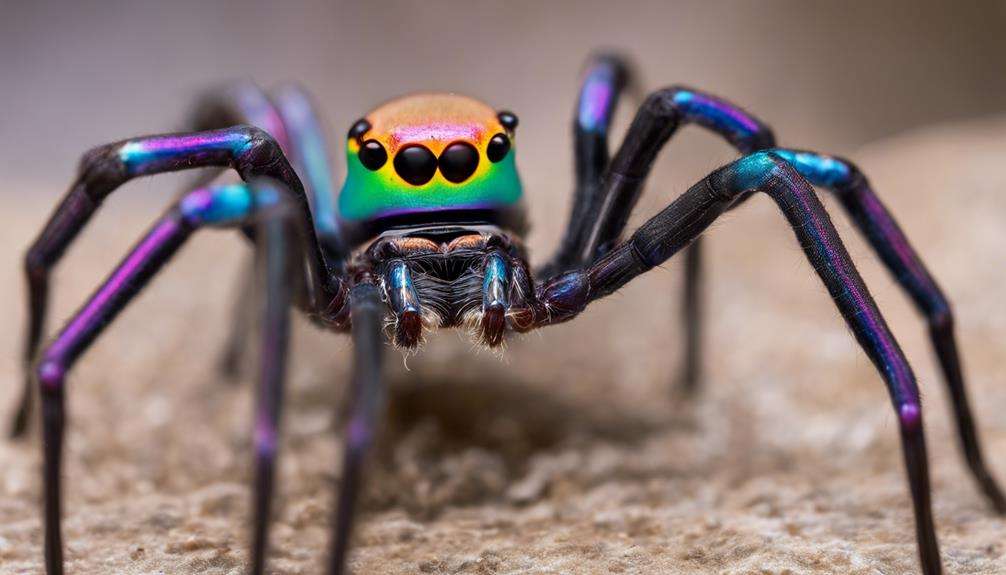
The unique jaw structure of the Sling-Jaw Spider, scientifically known as Dicrostichus furcatus, enables it to efficiently extend its fangs laterally for precise strikes during hunting. These spiders are expert hunters, utilizing their specialized jaws to swiftly subdue prey with accuracy. The Sling-Jaw Spider's agile movements and strategic hunting techniques make it a fascinating subject for observation.
Due to their specialized adaptations and alluring behaviors, the Sling-Jaw Spider presents a challenge and a rewarding experience for expert keepers. Their ability to extend their fangs laterally gives them a significant advantage in capturing prey, showcasing their evolution as efficient predators. Observing their precise strikes and agile movements can provide valuable insights into arachnid behavior and hunting strategies.
For those fascinated by the intricacies of arachnid biology and behavior, the Sling-Jaw Spider offers a unique opportunity for study and appreciation of nature's adaptations. Expert keepers willing to explore the world of these specialized hunters will find themselves enthralled by the Sling-Jaw Spider's remarkable abilities.
Tailless Whip Scorpion: Damon Diadema
Tailless Whip Scorpions, classified under the order Amblypygi, exhibit unique morphological features setting them apart from conventional arachnid species. Damon Diadema, commonly known as the Tailless Whip Scorpion, have elongated bodies and distinctive whip-like front legs that aid in sensory functions. Belonging to the order Amblypygi, they aren't true spiders, scorpions, or whip scorpions, showcasing a unique evolutionary path.
As nocturnal predators, Tailless Whip Scorpions like Damon Diadema thrive on a diet of insects and small invertebrates in their natural habitat. To maintain these fascinating creatures as pets, expert-level keepers must provide specialized care that caters to their specific biology and behaviors. Due to their specialized needs, including nocturnal activity patterns and dietary requirements, ensuring a suitable environment is vital for their well-being. Expert keepers should be attentive to mimic their natural habitat conditions closely to promote the health and longevity of Damon Diadema in captivity.
Spinybacked Orbweaver: Gasteracantha Cancriformis
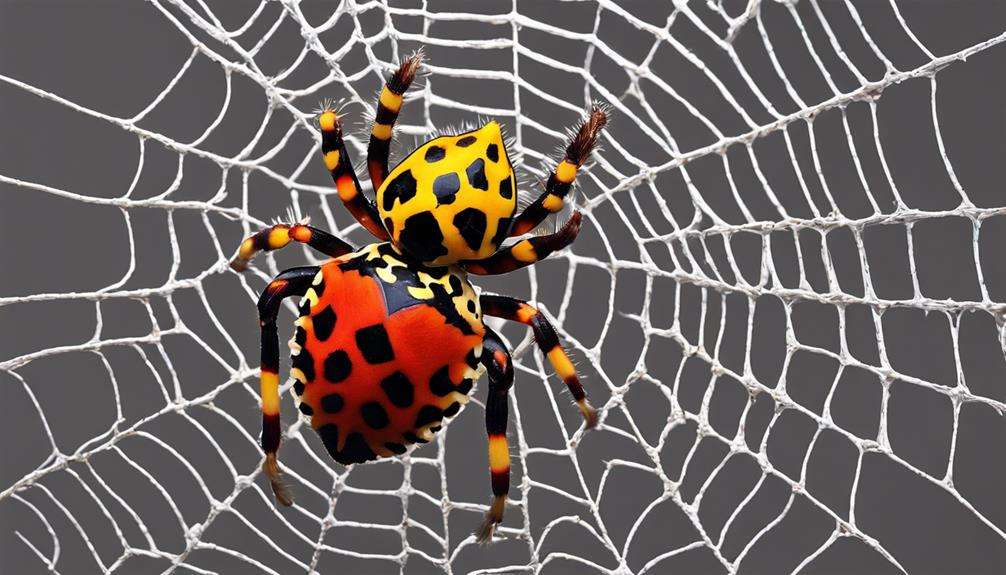
One of the most visually enchanting spider species for expert keepers is the Spinybacked Orbweaver, scientifically known as Gasteracantha cancriformis. This striking arachnid is easily recognizable by its distinctive spiny abdomen and vibrant markings, making it a mesmerizing choice for those with a keen eye for unique creatures.
The Spinybacked Orbweaver falls within a relatively small size range, with females typically measuring between 5-9 mm in length. What sets this species apart is its exceptional web-building abilities, constructing intricate orb-shaped webs that showcase both beauty and functionality.
Expert keepers are drawn to the Spinybacked Orbweaver not only for its visually striking appearance but also for its fascinating behaviors and the elaborate structures it creates. Observing these spiders in their natural habitat can provide valuable insights into their ecological role and behavioral patterns, making them a rewarding choice for those looking to explore deeper into the world of arachnids.
Frequently Asked Questions
What Is the Friendliest Spider to Have as a Pet?
The Brazilian Black Tarantula stands out as the friendliest spider for pets. Their calm temperament and docile nature make them ideal companions. Compared to other species, they are less aggressive and tolerant of handling, making them a top choice.
What Is the Friendliest Spider in the World?
When you wonder about the friendliest spider, think of the Brazilian White Knee Tarantula. Their calm demeanor and striking appearance make them a top choice. With unique behaviors, simple care, and potential for bonding experiences, they captivate expert keepers.
What Is the Smartest Pet Spider?
When it comes to smart pet spiders, Portia Labiata stands out for its intelligent behaviors, problem-solving skills, learning capabilities, memory retention, and cognitive abilities. Their advanced skills in hunting and traversing complex environments reflect their exceptional intelligence.
What Is the Best Pet to Keep Spiders Away?
To keep spiders away, you should focus on natural repellents, DIY remedies, and preventive measures. Planting mint, lavender, or citrus can act as safe alternatives to chemical sprays, creating a pest-controlled environment without harming beneficial insects.
Conclusion
As you navigate the intricate web of spider companionship, remember that each arachnid species holds a unique beauty and charm that can captivate even the most experienced keepers.
Like a delicate silk thread woven by a skilled weaver, the bond between you and your spider pet is a connection that requires patience, understanding, and dedication.
Embrace the diversity of these fascinating creatures, and let their presence spin a tapestry of wonder and fascination in your life.
